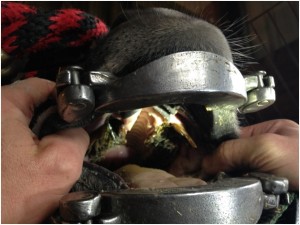Case Study: Donkey and Mini Teeth
Do Donkeys and Minis need their teeth worked on?
Need is a relative term. Teeth work, dentistry, is performed on horses for different reasons. Horse teeth are continuously erupting and are designed to wear each other off evenly. Problems arise when the teeth become uneven. Sharp edges and abrupt steps can develop – these make it hard for horses to move their heads well and this can impact chewing, but also athletic performance. Even horses with well balanced teeth usually need some help with sharp edges, or points.
Preventive dentistry, maintaining healthy and well balanced teeth is important to all equids. That should be stated at the outset. A high level dressage horse or talented reining horse needs more fine bit control than the 30 year kids’ walk – trotter, but the 30 year old needs his teeth well cared for so he can chew and digest efficiently. These differences are why we say the need is relative. Donkeys and minis are just as susceptible to dental abnormalities and disease as full size horses, and minis more so because of the reduced skull size. Both minis and donkeys are easy keepers so good chewing for efficient digestion is not usually a problem – in fact they are usually too heavy. Some of these guys pull carts but bit control is not often an issue. Here again we see that need is relative – do they need perfect dentition for the demands placed on their lives? Maybe not, but as you have no doubt heard, an ounce of prevention is worth a pound of cure. This is an especially accurate statement with regard to equine teeth – maintaining balance and overall oral health with regular dental exams and equilibrations is much preferable to trying to sort out problems later in life.
The donkey in this case was an older jenny, named Daisy. She had never had a dental exam, because she had never had a problem with her mouth. Recently, however, her owner noticed that Daisy’s cheeks were enlarged, or swollen. Daisy didn’t seem to be having trouble eating, in fact quite the opposite – she was still pretty excited about it.
On first inspection it did seem that Daisy’s cheeks were swollen, but a quick palpation revealed very sharp, firm points under normal cheeks. After some sedation a full mouth speculum was applied and a more thorough oral exam was completed. Daisy had some sharp points but for the most part, her overall dentition was good with normal alignment and wear. The one abnormality though, was a significant one. The first pre-molar on both sides of the upper arcade had been fractured, midline. The two fragments were separated widely with a considerable quantity of food packed in between. The fragments protruded into the center of her mouth and each cheek. The accumulating food was foul smelling and causing gingival disease. We addressed the points and minor imbalances first, then removed the loose fragments and food from the first premolars.
Daisy handled the entire procedure well (she did leave the stall once, despite being sedated – we’ll chalk that up to donkey contrariness) and ate better that night. Going forward though, the loss of the first upper premolars has created a significant imbalance and will likely mean she needs regular dental care to prevent overgrowth of the lower first premolars and more issues.




